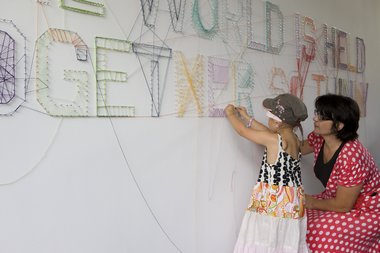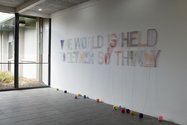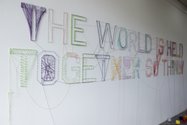John Hurrell – 30 March, 2011
The outlines of his carefully positioned nails say ‘The World Is Held Together So Thinly' - a comment perhaps on the fragility of corporeal existence and the striving for a comprehending mental view of the actions of other creatures (sentient or otherwise). Or a reference to our cities' vulnerability to earthquakes. Or even the fragility of social bonding. It's highly ambiguous.
Currently installed on the Te Tuhi Drawing Wall is an interactive ‘drawing’ by Elliot Collins where selected members of the public are invited to modify the visual ingredients of the work, these being a sentence written on the wall via lettershapes that are elucidated by hammered-in nails. There are also twelve attached balls of thin coloured string. The process alludes to the mathematical (geometrical) string wall decorations that became popular in the sixties, and Collins is well known for his colourful text-based paintings.
The outlines of his carefully positioned nails say ‘The World Is Held Together So Thinly’ - a comment perhaps on the fragility of corporeal existence and the striving for a comprehending mental view of the actions of other creatures (sentient or otherwise). Or a reference to our cities’ vulnerability to earthquakes. Or even the fragility of social bonding. It’s highly ambiguous.
As for combining the materials, there are many ways of winding on the string, some to clarify the letter shapes and words, others to obliterate them by destroying contours. It is even possible to create new words and new phrases through careful selection and editing and placement of swathes of colour.
This sort of process of course is not new. The young Jasper Johns modified letter shapes with encaustic and toyed around with language content using paradox. Others like Tom Phillips have used found texts within old novels to create entirely new ‘novels’ through careful word selection, and colouring over what was not needed.
As Collins’ exhibition is on for over two months, each wound on colour/language variation - after it reaches maximum density - gets photographed and then cut down. That way someone else can have a go at manipulating the string, starting again from scratch.
Apart from possible pleasures to be discovered within the resulting coloured texts, what is interesting is how a single individual might attempt to express a focussed approach in the face of (perhaps) chaos generated by a group of individuals - how they might negotiate that. Do they work in one long frenetic burst, or intermittently in stages - explaining their approach to others wanting to participate, and perhaps collaborating? Is verbal communication essential for success?
In fact spoken communication really is a part of this project because the wall label doesn’t directly ask visitors to participate. That happens only when particular communities are approached by the artist, or when gallery staff happen to see visitors pondering the work and then invite them.
Outside issues of whether such control might be excessive and dampen enthusiastic participation, that different community groups might consistently create distinctive string configurations (aligned with their own particular cultural ethos) is a possibility. Collins and Te Tuhi will obviously study the documentation of all the ‘drawings’ and see if any detectable patterns emerge. The results might be surprising.
John Hurrell






 Two Rooms presents a program of residencies and projects
Two Rooms presents a program of residencies and projects Advertising in this column
Advertising in this column



This Discussion has 0 comments.
Comment
Participate
Register to Participate.
Sign in
Sign in to an existing account.